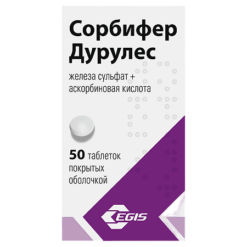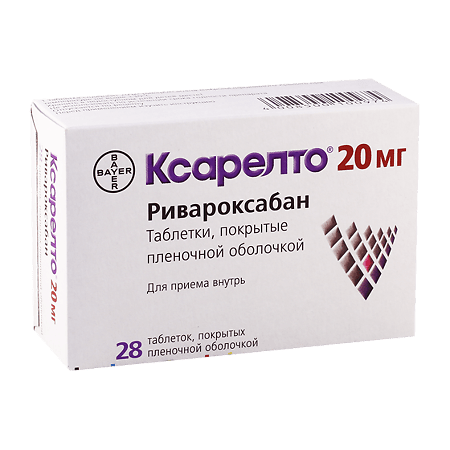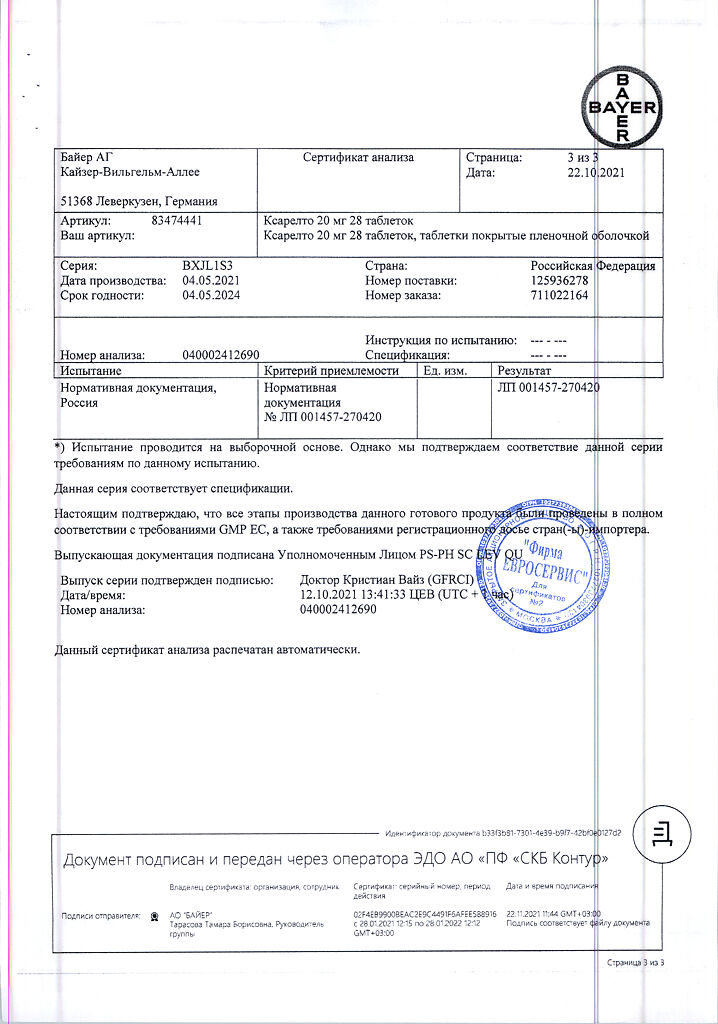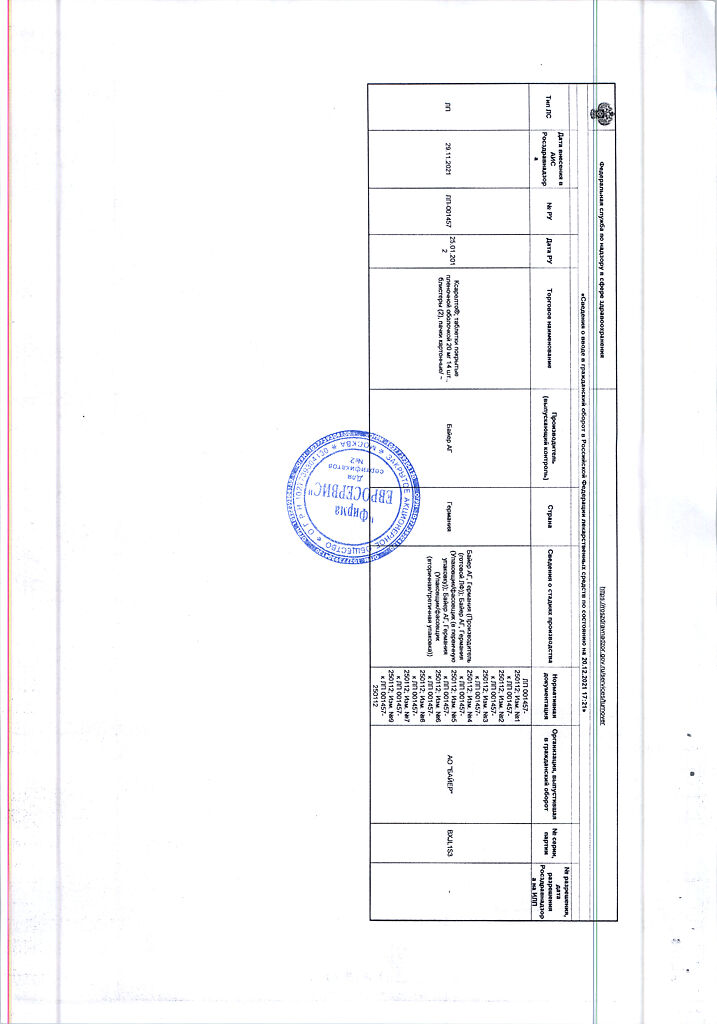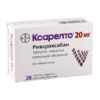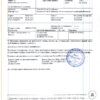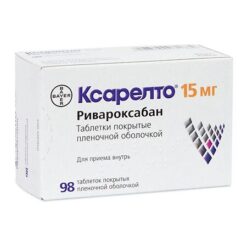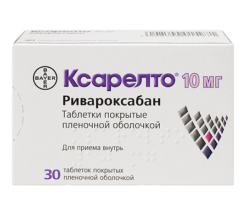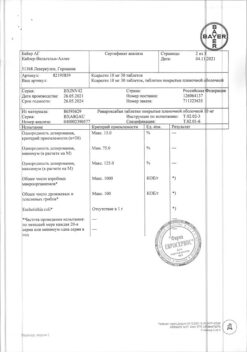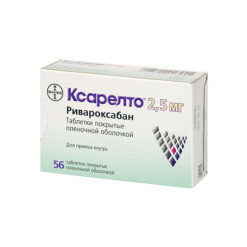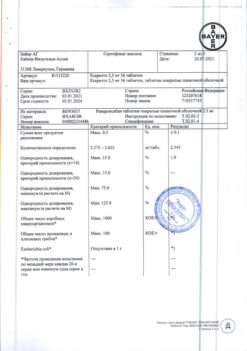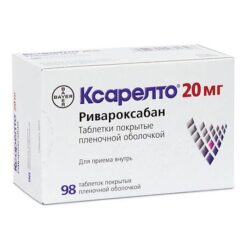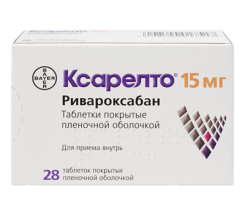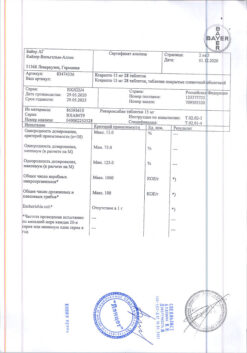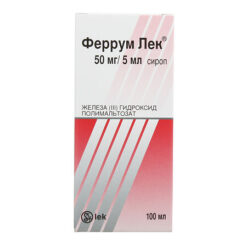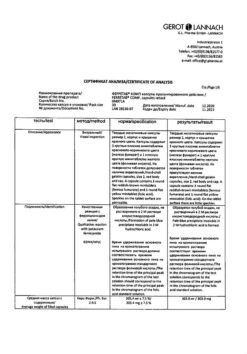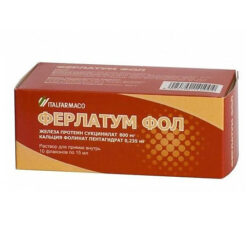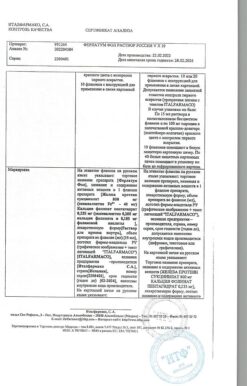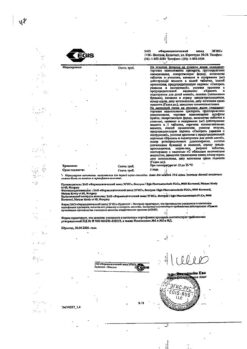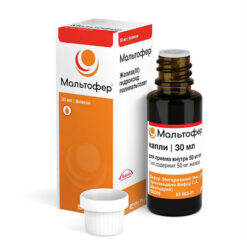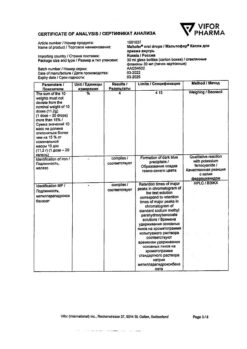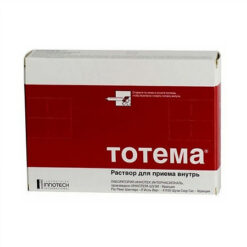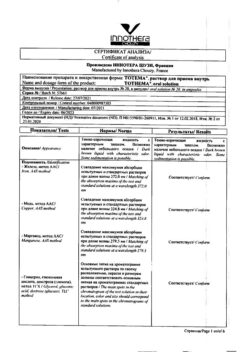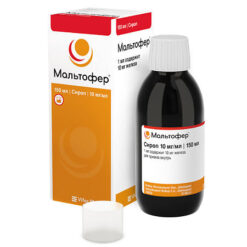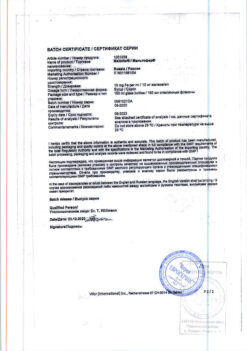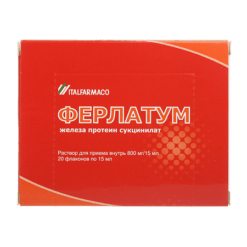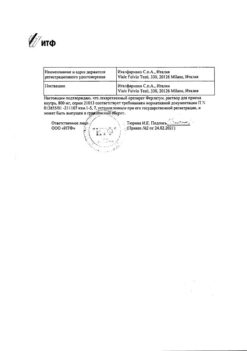Subtotal: €16.75
Xarelto, 20 mg 28 pcs
€88.49 €73.75
Rivaroxaban is a highly selective direct factor Xa inhibitor with high bioavailability when taken orally.
The activation of factor X to form factor Xa through the internal and external clotting pathways plays a central role in the coagulation cascade.
Pharmacodynamic effects
Dose-dependent inhibition of factor Xa has been observed in humans. Rivaroxaban has a dose-dependent effect on prothrombin time and correlates well with plasma concentrations (r=0.98) when using the Neoplastin® kit for the assay. Results will vary if other reagents are used. Prothrombin time should be measured in seconds, because MHO is only calibrated and certified for coumarin derivatives and cannot be used for other anticoagulants.
In patients with non-valvular atrial fibrillation taking rivaroxaban for prevention of stroke and systemic thromboembolism, the 5/95 percentile for prothrombin time (Neoplastin®) 1-4 h after taking the tablet (ie.i.e., at maximum effect) range from 14 to 40 seconds in patients taking 20 mg once daily and from 10 to 50 seconds in patients with renal impairment (CKR 49 to 30 mL/min) taking 15 mg once daily.
In patients receiving rivaroxaban for the treatment and prevention of recurrent deep vein thrombosis (DVT) and pulmonary embolism (PATE), 5/95 percentiles for prothrombin time (Neoplastin®) 2-4 h after taking the tablet (ie.i.e., at maximum effect) range from 17 to 32 seconds in patients taking 15 mg 2 times/day and from 15 to 30 seconds in patients taking 20 mg once/day.
Rivaroxaban also dose-dependently increases the ABTV and HepTest® result; however, these parameters are not recommended for evaluating the pharmacodynamic effects of rivaroxaban. Also, if clinically warranted, rivaroxaban concentrations may be measured using a calibrated quantitative anti-Factor Xa test.
Monitoring of clotting parameters is not required during treatment with Xarelto® .
In healthy men and women over 50 years of age, prolongation of the QT interval was not observed with rivaroxaban.
Indications
— prevention of stroke and systemic thromboembolism in patients with non-valvular atrial fibrillation;
– treatment of deep vein thrombosis and pulmonary embolism and prevention of relapses of DVT and PE.
Pharmacological effect
Rivaroxaban is a highly selective direct factor Xa inhibitor with high oral bioavailability.
Activation of factor X to form factor Xa through the intrinsic and extrinsic coagulation pathways plays a central role in the coagulation cascade.
Pharmacodynamic effects
In humans, dose-dependent inhibition of factor Xa was observed. Rivaroxaban has a dose-dependent effect on prothrombin time and correlates well with plasma concentrations (r=0.98) when the Neoplastin® kit is used for analysis. Results will vary if other reagents are used. Prothrombin time should be measured in seconds because MHO is calibrated and certified only for coumarin derivatives and cannot be used for other anticoagulants.
In patients with nonvalvular atrial fibrillation taking rivaroxaban for the prevention of stroke and systemic thromboembolism, the 5/95 percentile for prothrombin time (Neoplastin®) 1 to 4 hours after tablet dosing (i.e., at maximum effect) ranges from 14 to 40 sec in patients taking 20 mg once daily, and from 10 to 50 sec in patients with renal failure (creatinine clearance 49-30 ml/min) taking 15 mg 1 time/day.
In patients receiving rivaroxaban for the treatment and prevention of recurrent deep vein thrombosis (DVT) and pulmonary embolism (PE), the 5/95th percentile for prothrombin time (Neoplastin®) 2 to 4 hours after tablet dosing (i.e., at maximum effect) ranges from 17 to 32 sec in patients taking 15 mg twice daily and from 15 to 30 sec in patients taking 20 mg 1 time/day.
Also, rivaroxaban dose-dependently increases APTT and HepTest® result; however, these parameters are not recommended for assessing the pharmacodynamic effects of rivaroxaban. Also, if clinically warranted, rivaroxaban concentrations can be measured using a calibrated quantitative anti-factor Xa test.
During treatment with Xarelto®, monitoring of blood coagulation parameters is not required.
In healthy men and women over 50 years of age, prolongation of the QT interval under the influence of rivaroxaban was not observed.
Special instructions
The use of Xarelto is not recommended in patients receiving concomitant systemic treatment with azole antifungals (eg, ketoconazole) or HIV protease inhibitors (eg, ritonavir). These drugs are strong inhibitors of CYP3A4 and P-glycoprotein. Thus, these drugs may increase plasma concentrations of rivaroxaban to clinically significant levels (2.6-fold on average), which may lead to an increased risk of bleeding. However, the azole antifungal fluconazole, a moderate inhibitor of CYP3A4, has a less pronounced effect on rivaroxaban exposure and can be used concomitantly with it.
Xarelto should be used with caution in patients with moderate renal impairment (creatinine clearance 49-30 ml/min) receiving concomitant medications that may lead to increased plasma concentrations of rivaroxaban. In patients with renal insufficiency with creatinine clearance <30 ml/min, the plasma concentration of rivaroxaban may be significantly increased (1.6 times on average), which may lead to an increased risk of bleeding. Therefore, due to the presence of this underlying disease, such patients have an increased risk of developing both bleeding and thrombosis. Due to the limited amount of clinical data, Xarelto® should be used with caution in patients with a CC of 29-15 ml/min. There are no clinical data on the use of rivaroxaban in patients with severe renal impairment (creatinine clearance < 15 ml/min). Therefore, the use of Xarelto® is not recommended in such patients.
Patients with severe renal impairment or an increased risk of bleeding, as well as patients receiving concomitant systemic treatment with azole antifungals or HIV protease inhibitors, should be closely monitored for signs of bleeding after initiation of treatment.
Xarelto®, like other antithrombotic agents, should be used with caution in patients at increased risk of bleeding, including:
– patients with a congenital or acquired tendency to bleeding;
-patients with uncontrolled severe arterial hypertension;
– patients with gastric and duodenal ulcers in the acute phase;
– patients who have recently suffered from gastric and duodenal ulcers;
-patients with vascular retinopathy;
– patients who have recently suffered intracranial or intracerebral hemorrhage;
– patients with pathology of the blood vessels of the brain or spinal cord;
-patients who have recently undergone surgery on the brain, spinal cord or eyes;
-patients with a history of bronchiectasis or pulmonary hemorrhage.
Caution should be exercised if the patient is concomitantly receiving medications that affect hemostasis, such as NSAIDs, platelet aggregation inhibitors, or other antithrombotic drugs.
Patients at risk of developing gastric and duodenal ulcers may be prescribed appropriate preventive treatment.
If there is an unexplained decrease in hemoglobin or blood pressure, it is necessary to look for the source of bleeding.
The safety and effectiveness of Xarelto® in patients with artificial heart valves have not been studied; therefore, there is no data confirming that the use of Xarelto® 20 mg (15 mg in patients with creatinine clearance 49-15 ml/min) provides a sufficient anticoagulant effect in this category of patients.
Xarelto® is not recommended as an alternative to unfractionated heparin in patients with hemodynamically unstable pulmonary embolism or in patients who may require thrombolysis or thrombectomy, since the safety and effectiveness of Xarelto® in these clinical situations has not been established.
If an invasive procedure or surgery is necessary, Xarelto® should be discontinued at least 24 hours before the procedure and based on the doctor’s opinion.
If the procedure cannot be delayed, the increased risk of bleeding should be weighed against the need for urgent intervention.
Xarelto® should be restarted after an invasive procedure or surgery, provided that appropriate clinical indicators and adequate hemostasis are present.
When performing epidural/spinal anesthesia or spinal puncture in patients receiving platelet aggregation inhibitors to prevent thromboembolic complications, there is a risk of developing an epidural or spinal hematoma, which can lead to prolonged paralysis.
The risk of these events is further increased by the use of an indwelling epidural catheter or concomitant therapy with drugs that affect hemostasis. Traumatic epidural or spinal puncture or repeat puncture may also increase the risk.
Patients should be monitored for signs and symptoms of neurological impairment (eg, numbness or weakness of the legs, bowel or bladder dysfunction). If neurological disorders are detected, urgent diagnosis and treatment are necessary.
The physician should weigh the potential benefit against the relative risk before performing spinal surgery in patients receiving anticoagulants or who are scheduled to receive anticoagulants for the purpose of preventing thrombosis. There is no clinical experience with the use of rivaroxaban in doses of 15 mg and 20 mg in the situations described.
To reduce the potential risk of bleeding associated with concomitant use of rivaroxaban and epidural/spinal anesthesia or spinal puncture, the pharmacokinetic profile of rivaroxaban should be considered. Insertion or removal of an epidural catheter or lumbar puncture is best performed when the anticoagulant effect of rivaroxaban is assessed as weak. However, the exact time to achieve a sufficiently low anticoagulant effect in each patient is unknown.
Based on general pharmacokinetic characteristics, the epidural catheter is removed after at least twice T1/2, i.e. no earlier than 18 hours after taking the last dose of Xarelto® for young patients and no earlier than 26 hours for elderly patients. Xarelto® should be prescribed no earlier than 6 hours after removal of the epidural catheter.
In case of traumatic puncture, Xarelto® should be postponed for 24 hours.
Safety data obtained from nonclinical studies
With the exception of effects associated with enhanced pharmacological action (bleeding), analysis of preclinical data obtained in pharmacological safety studies did not reveal any specific hazard to humans.
Impact on the ability to drive vehicles and operate machinery
Cases of fainting and dizziness have been reported when using Xarelto®. Patients who experience these adverse reactions should not drive vehicles or work with moving machinery.
Active ingredient
Rivaroxaban
Composition
1 tablet contains:
rivaroxaban micronized 20 mg.
Contraindications
– hypersensitivity to rivaroxaban or any auxiliary components of the drug;
– clinically significant active bleeding (for example, intracranial bleeding, gastrointestinal bleeding);
– injury or condition associated with an increased risk of major bleeding, for example, a current or recent gastrointestinal ulcer, the presence of malignant tumors with a high risk of bleeding, recent trauma to the brain or spinal cord, surgery on the brain, spinal cord or eyes, intracranial hemorrhage, diagnosed or suspected esophageal varices, arteriovenous malformations, vascular aneurysms or vascular pathology of the brain or spinal cord brain;
– concomitant therapy with any other anticoagulants, for example, unfractionated heparin, low molecular weight heparins (including enoxaparin, dalteparin), heparin derivatives (including fondaparinux), oral anticoagulants (including warfarin, apixaban, dabigatran), except in cases of switching from or to rivaroxaban or when using unfractionated heparin in doses necessary to ensure the functioning of the central venous or arterial catheter;
– liver diseases occurring with coagulopathy, which causes a clinically significant risk of bleeding;
– renal failure with CC < 15 ml/min (clinical data on the use of rivaroxaban in this category of patients are absent);
– treatment of ACS with antiplatelet agents in patients who have suffered a stroke or transient ischemic attack;
– pregnancy;
– lactation period (breastfeeding period);
– children and adolescents under 18 years of age (efficacy and safety for patients in this age group have not been established);
– congenital lactase deficiency, lactose intolerance, glucose-galactose malabsorption (due to the presence of lactose in the composition).
The drug should be used with caution:
– in the treatment of patients with an increased risk of bleeding (including congenital or acquired tendency to bleeding, uncontrolled severe arterial hypertension, peptic ulcer of the stomach and duodenum in the acute phase, recent peptic ulcer of the stomach and duodenum, vascular retinopathy, bronchiectasis or a history of pulmonary hemorrhage);
– in the treatment of patients with renal failure (creatinine clearance 49-30 ml/min) who are simultaneously receiving drugs that increase the concentration of rivaroxaban in the blood plasma;
– when treating patients with renal failure (creatinine clearance 29-15 ml/min), caution should be exercised, since the concentration of rivaroxaban in the blood plasma in such patients can increase significantly (on average 1.6 times) and as a result they are at increased risk of bleeding;
– in patients receiving medications that affect hemostasis (for example, NSAIDs, antiplatelet agents or other antithrombotic agents);
— Xarelto® is not recommended for use in patients receiving systemic treatment with azole antifungals (for example, ketoconazole) or HIV protease inhibitors (for example, ritonavir). These drugs are strong inhibitors of the CYP3A4 isoenzyme and P-glycoprotein. As a consequence, these drugs may increase plasma concentrations of rivaroxaban to clinically significant levels (on average 2.6-fold), which increases the risk of bleeding. Fluconazole (an azole antifungal), a moderate CYP3A4 inhibitor, has a less pronounced effect on the exposure of rivaroxaban and can be used concomitantly with it;
– Patients with renal failure with a creatinine clearance of 15-29 ml/min or an increased risk of bleeding and patients receiving concomitant systemic treatment with azole antifungals or HIV protease inhibitors should be closely monitored after initiation of treatment for timely detection of complications in the form of bleeding.
Side Effects
The safety of Xarelto® was assessed in four phase III studies involving 6097 patients undergoing major lower extremity orthopedic surgery (total knee or total hip replacement) and 3997 patients hospitalized for medical reasons treated with Xarelto® 10 mg for up to 39 days, as well as in three phase III studies for the treatment of venous thromboembolism, including 4556 patients treated with Xarelto® at a dose of either 15 mg twice daily for 3 weeks, followed by a dose of 20 mg once daily or 20 mg once daily for up to 21 months.
In addition, two phase III studies, including 7,750 patients, provided safety data in patients with nonvalvular atrial fibrillation who received at least one dose of Xarelto® for up to 41 months, as well as 10,225 patients with ACS who received at least one dose of Xarelto® 2.5 mg (2 times / day) or 5 mg (2 times / day). times/day) in addition to therapy with acetylsalicylic acid or acetylsalicylic acid with clopidogrel or ticlopidine, treatment duration is up to 31 months.
Given the mechanism of action, the use of Xarelto may be accompanied by an increased risk of latent or overt bleeding from any organs and tissues, which can lead to posthemorrhagic anemia. The risk of bleeding may increase in patients with uncontrolled arterial hypertension and/or when used together with drugs that affect hemostasis. Signs, symptoms, and severity (including possible death) vary depending on the location, intensity, or duration of bleeding and/or anemia. Hemorrhagic complications can manifest as weakness, pallor, dizziness, headache, shortness of breath, as well as enlargement of the limb or shock, which cannot be explained by other reasons. In some cases, symptoms of myocardial ischemia, such as chest pain and angina, developed as a result of anemia.
Known complications secondary to severe bleeding, such as compartment syndrome and renal failure due to hypoperfusion, have also been reported with the use of Xarelto®. Therefore, the possibility of bleeding should be considered when assessing any patient receiving anticoagulants.
A summary of the incidence of adverse reactions reported for Xarelto® is given below. In groups divided by frequency, adverse effects are presented in order of decreasing severity, as follows: common: ≥1% to <10% (≥1/100 to <1/10); uncommon: from ≥0.1% to <1% (from ≥1/1000 to <1/100); rare: from ≥0.01% to <0.1% (from ≥1/10,000 to <1/1000); very rare: <0.01% (<1/10,000).
All adverse reactions that occurred during treatment in patients participating in phase III clinical trials
From the hematopoietic system: often – anemia (including relevant laboratory parameters); uncommon – thrombocythemia (including elevated platelet counts)*.
From the cardiovascular system: often – pronounced decrease in BP, hematoma; infrequently – tachycardia.
From the organ of vision: often – hemorrhage in the eye (including hemorrhage in the conjunctiva).
From the digestive system: often – bleeding gums, gastrointestinal bleeding (including rectal bleeding), pain in the gastrointestinal tract, dyspepsia, nausea, constipation*, diarrhea, vomiting*; infrequently – dry mouth.
System disturbances and reactions at the place of administration drug: often – fever*, peripheral swelling, decrease in total muscle strength and tone (including weakness, asthenia); infrequently – deterioration general well-being (including malaise); rarely – local edema*.
From the liver: infrequently – impaired liver function; rarely – jaundice.
Research results: often – increased activity of liver transaminases; infrequently – increased bilirubin concentration, increased alkaline phosphatase activity*, increased LDH activity*, increased lipase activity*, increased amylase activity*, increased GGT activity*; rarely – an increase in the concentration of conjugated bilirubin (with or without a concomitant increase in ALT activity).
From the nervous system: often – dizziness, headache; infrequently – intracerebral and intracranial hemorrhage, short-term fainting.
From the genitourinary system: often – bleeding from the urogenital tract (including hematuria and menorrhagia**), renal failure (including increased creatinine concentration, increased urea concentration)*.
From the respiratory system: often – nosebleeds, hemoptysis.
From the skin and subcutaneous tissues: often – itching (including rare cases of generalized itching), rash, ecchymosis, skin and subcutaneous hemorrhages; infrequently – urticaria.
From the immune system: rarely – allergic reactions, allergic dermatitis.
From the musculoskeletal system: often – pain in the limbs*; infrequently – hemarthrosis; rarely – hemorrhage into the muscles.
System violations and reactions in place introduction drug: often – fever*, peripheral edema, deterioration in general health (including weakness, asthenia); infrequently – deterioration in general health (including malaise); rarely – local swelling*.
Injuries poisoning and procedural complications: often – hemorrhages after procedures (including postoperative anemia and bleeding from the wound), excessive hematoma due to bruise; infrequently – discharge from the wound*; rarely – vascular pseudoaneurysm***.
* were registered after major orthopedic operations.
** reported in the treatment of VTE as very common in women <55 years of age.
*** were registered as infrequent in the prevention of sudden death and myocardial infarction in patients after acute coronary syndrome (after percutaneous interventions).
During post-marketing monitoring, cases of the following adverse reactions were reported, the development of which had a temporary connection with the use of Xarelto®. It is not possible to assess the frequency of occurrence of such adverse reactions within the framework of post-registration monitoring.
From the immune system: angioedema, allergic edema. In the phase III RCT, such adverse effects were considered infrequent (>1/1000 to <1/100).
From the liver: cholestasis, hepatitis (including hepatocellular damage). In the phase III RCT, such adverse effects were considered rare (>1/10,000 to <1/1000).
From the hematopoietic system: thrombocytopenia. In the phase III RCT, such adverse effects were considered infrequent (>1/1000 to <1/100).
From the musculoskeletal system: frequency unknown – increased subfascial pressure syndrome (compartment syndrome) due to hemorrhage into the muscles.
From the urinary system: frequency unknown – renal failure/acute renal failure due to bleeding leading to renal hypoperfusion.
Interaction
Pharmacokinetic interaction
Rivaroxaban is eliminated primarily through hepatic metabolism mediated by the cytochrome P450 system (CYP3A4, CYP2J2), as well as through renal excretion of unchanged drug using the P-gp/Bcrp (P-glycoprotein/breast cancer resistance protein) transporter systems.
Rivaroxaban does not suppress or induce the CYP3A4 isoenzyme and other important cytochrome isoforms.
Concomitant use of rivaroxaban and strong inhibitors of CYP3A4 and P-glycoprotein may result in decreased renal and hepatic clearance and thus significantly increase systemic exposure.
The combined use of rivaroxaban and the azole antifungal agent ketoconazole (400 mg 1 time / day), which is a strong inhibitor of CYP3A4 and P-glycoprotein, led to an increase in the average steady-state AUC of rivaroxaban by 2.6 times and an increase in the average Cmax of rivaroxaban by 1.7 times, which was accompanied by a significant increase in the pharmacodynamic effect of the drug.
Co-administration of Xarelto® and the HIV protease inhibitor ritonavir (600 mg 2 times / day), which is a powerful inhibitor of CYP3A4 and P-glycoprotein, led to an increase in the average steady-state AUC of rivaroxaban by 2.5 times and an increase in the average Cmax of rivaroxaban by 1.6 times, which was accompanied by a significant increase in the pharmacodynamic effect of the drug. In this regard, Xarelto® is not recommended for use in patients receiving systemic treatment with azole antifungals or HIV protease inhibitors.
Clarithromycin (500 mg 2 times/day), a potent inhibitor of the CYP3A4 isoenzyme and a moderate inhibitor of P-glycoprotein, caused an increase in AUC values by 1.5 times and Cmax of rivaroxaban by 1.4 times. This increase is of the order of normal variability in AUC and Cmax and is considered clinically insignificant.
Erythromycin (500 mg 3 times/day), a moderate inhibitor of the CYP3A4 isoenzyme and P-glycoprotein, caused an increase in the AUC and Cmax values of rivaroxaban by 1.3 times. This increase is of the order of normal variability in AUC and Cmax and is considered clinically insignificant.
In patients with renal deficiency (CC ≤ 80-50 ml/min) erythromycin (500 mg 3 times/day) caused increasing values AUC of rivaroxaban in 1.8 times and Cmax in 1.6 times by comparison with patients s normal function kidneys, did not receive accompanying therapy. In patients s renal insufficiency (QC 49-30 ml/min) erythromycin caused an increase values AUC of rivaroxaban in 2.0 times and Cmax in 1.6 times compared to s patients with normal kidney function, did not receive accompanying therapy.
Fluconazole (400 mg 1 time / day), a moderate inhibitor of the CYP3A4 isoenzyme, caused an increase in the average AUC of rivaroxaban by 1.4 times and an increase in the average Cmax by 1.3 times. This increase is of the order of normal variability in AUC and Cmax and is considered clinically insignificant.
Concomitant use of rivaroxaban with dronedarone should be avoided due to limited clinical data on coadministration.
Co-administration of Xarelto® and rifampicin, which is a strong inducer of CYP3A4 and P-glycoprotein, led to a decrease in the mean AUC of rivaroxaban by approximately 50% and a parallel decrease in its pharmacodynamic effects.
Concomitant use of rivaroxaban with other strong CYP3A4 inducers (eg, phenytoin, carbamazepine, phenobarbital or St. John’s wort) may also result in decreased plasma concentrations of rivaroxaban. The decrease in plasma concentrations of rivaroxaban was considered clinically insignificant.
Strong CYP3A4 inducers should be used with caution.
Pharmacodynamic interaction
Following concomitant use of enoxaparin sodium (single dose 40 mg) and Xarelto® (single dose 10 mg), a additive effect on anti-factor Xa activity was observed, without additional additive effects on blood clotting tests (prothrombin time, aPTT). Enoxaparin did not change the pharmacokinetics of rivaroxaban.
Due to the increased risk of bleeding, caution should be exercised when used together with any other anticoagulants.
No pharmacokinetic interaction was found between Xarelto® at a dose of 15 mg and clopidogrel (loading dose of 300 mg followed by a maintenance dose of 75 mg), but in a subgroup of patients a significant increase in bleeding time was found, which did not correlate with the degree of platelet aggregation and the content of P-selectin or GPIIb/IIIa receptor.
After co-administration of Xarelto® (15 mg) and naproxen (500 mg), no clinically significant increase in bleeding time was observed. However, a more pronounced pharmacodynamic response is possible in some individuals.
Caution should be exercised when using Xarelto® together with NSAIDs (including acetylsalicylic acid) and platelet aggregation inhibitors, since the use of these drugs usually increases the risk of bleeding.
Switching patients from warfarin (MHO 2 to 3) to Xarelto® (20 mg) or from Xarelto® (20 mg) to warfarin (MHO 2 to 3) increased prothrombin time/INR (Neoplastin) to a greater extent than would be expected from simple summation of effects (individual MHO values can be as high as 12), while affecting aPTT, suppressing factor Xa activity and endogenous thrombin potential was additive.
If it is necessary to study the pharmacodynamic effects of Xarelto® during the transition period, anti-Xa activity, PiCT and HepTest® can be used as necessary tests that are not affected by warfarin. Starting from the 4th day after stopping the use of warfarin, all test results (including PT, APTT, inhibition of factor Xa activity and EPT (endogenous thrombin potential)) reflect only the effect of Xarelto®.
If it is necessary to study the pharmacodynamic effects of warfarin during the transition period, measuring the MHO value at Interim can be used. rivaroxaban (24 hours after the previous dose of rivaroxaban), since rivaroxaban has minimal effect on this indicator during this period.
No pharmacokinetic interactions have been reported between warfarin and Xarelto®.
The drug interaction of Xarelto® with VKA phenindione has not been studied. It is recommended, whenever possible, to avoid transferring patients from Xarelto® therapy to VKA phenindione therapy and vice versa. There is limited experience converting patients from VKA acenocoumarol therapy to Xarelto®.
If there is a need to transfer a patient from Xarelto® therapy to VKA therapy with phenindione or acenocoumarol, then special care should be taken; daily monitoring of the pharmacodynamic effect of the drugs (MHO, prothrombin time) should be carried out immediately before taking the next dose of Xarelto®. If there is a need to transfer a patient from VKA therapy with phenindione or acenocoumarol to therapy with Xarelto®, then special care should be taken; monitoring of the pharmacodynamic effect of the drugs is not required.
Incompatibility
Unknown.
No interaction detected
No pharmacokinetic interactions have been identified between rivaroxaban and midazolam (CYP3A4 substrate), digoxin (P-gp substrate) or atorvastatin (CYP3A4 and P-gp substrate).
Co-administration with the proton pump inhibitor omeprazole, the histamine H2 receptor blocker ranitidine, aluminum hydroxide/magnesium hydroxide antacids, naproxen, clopidogrel or enoxaparin does not affect the bioavailability and pharmacokinetics of rivaroxaban.
No clinically significant pharmacokinetic or pharmacodynamic interaction was observed with the combined use of Xarelto® and acetylsalicylic acid at a dose of 500 mg.
Effect on laboratory parameters
Xarelto® affects blood clotting parameters (prothrombin time, APTT, Hep-Test®) due to its mechanism of action.
Overdose
Rare cases of overdose have been reported when taking rivaroxaban up to 600 mg without bleeding or other adverse reactions. Due to limited absorption, the development of a low-level plateau in drug concentrations is expected without a further increase in its average plasma concentration when used in doses exceeding therapeutic doses (≥50 mg).
Treatment
The specific antidote for rivaroxaban is unknown. In case of overdose, activated charcoal can be used to reduce the absorption of rivaroxaban. Given its extensive binding to plasma proteins, it is expected that rivaroxaban will not be eliminated during dialysis.
If in the patient receiving rivaroxaban, arose complication in form bleeding, next reception the drug should postpone or, at necessity, cancel treatment data drug. T1/2 of rivaroxaban lasts approximately 5-13 hours. Treatment should be selected individually, according to the severity and location of bleeding.
If necessary, appropriate symptomatic treatment can be used, such as mechanical compression (for example, for severe epistaxis), surgical hemostasis with evaluation of its effectiveness, fluid therapy and hemodynamic support, the use of blood products (packed red blood cells or fresh frozen plasma, depending on concomitant anemia or coagulopathy) or platelets.
If the measures listed above do not lead to the elimination of bleeding, may be prescribed specific procoagulant drugs reverse actions, such how factors coagulation blood II, VII, IX and X in combination[Prothrombin complex], anti-inhibitory coagulant complex or eptacog alpha [activated]. However currently experience application of these drugs in patients receiving Xarelto®, very limited.
Protamine sulfate and vitamin K are not expected to affect the anticoagulant activity of rivaroxaban.
There is limited experience applications tranexamova acids and no experience application of aminocaproic acid and aprotinin in patients, receiving Xarelto®. There is no scientific basis for or experience with the use of the systemic hemostatic drug desmopressin in patients receiving Xarelto®.
Functional features
Suction
Rivaroxaban is rapidly absorbed; Cmax is achieved 2-4 hours after taking the tablet. The absolute bioavailability of rivaroxaban after taking a dose of 10 mg is high (80-100%). When taking rivaroxaban at a dose of 10 mg with food, there was no change in AUC and Cmax. The pharmacokinetics of rivaroxaban is characterized by moderate individual variability; individual variability (variation coefficient) ranges from 30% to 40%.
When taking the drug at a dose of 20 mg on an empty stomach, a bioavailability of 66% was observed, due to a reduced degree of absorption. When Xarelto® was administered at a dose of 20 mg with food, there was a 39% increase in mean AUC compared to fasting, indicating almost complete absorption and high bioavailability.
The absorption of rivaroxaban depends on the site of release in the gastrointestinal tract. Reductions in AUC and Cmax of 29% and 56%, respectively, compared to whole tablet administration, were observed when rivaroxaban granules were released in the distal small intestine or ascending colon. Administration of rivaroxaban into the gastrointestinal tract distal to the stomach should be avoided, as this may result in decreased absorption and, consequently, decreased exposure of the drug.
The study assessed the bioavailability (AUC and Cmax) of rivaroxaban administered orally at a dose of 20 mg as a crushed tablet mixed with applesauce or suspended in water, or given by gastric tube followed by a liquid diet, compared with administration of a whole tablet. The results demonstrated a predictable dose-dependent pharmacokinetic profile for rivaroxaban, with bioavailability at the above dosing levels consistent with lower doses of rivaroxaban.
Distribution
In the human body, most of rivaroxaban (92-95%) is bound to plasma proteins, the main binding component being serum albumin. Vd – moderate, Vss is approximately 50 l.
Metabolism
When taken orally, approximately 2/3 of the prescribed dose of rivaroxaban is metabolized and subsequently excreted in equal parts in urine and feces. The remaining 1/3 of the dose is eliminated unchanged by direct renal excretion, mainly due to active renal secretion.
Rivaroxaban is metabolized through isoenzymes CYP3A4, CYP2J2, as well as through mechanisms independent of the cytochrome system. The main sites of biotransformation are the oxidation of the morpholine group and the hydrolysis of amide bonds.
According to in vitro data, rivaroxaban is a substrate for the transporter proteins P-gp (P-glycoprotein) and Bcrp (breast cancer resistance protein).
Unmodified rivaroxaban is the only active compound in plasma; no significant or active circulating metabolites have been detected in plasma.
Removal
Rivaroxaban, whose systemic clearance is approximately 10 L/h, can be classified as a drug with a low clearance rate.
When rivaroxaban is eliminated from plasma, the final T1/2 ranges from 5 to 9 hours in young patients.
Pharmacokinetics in special clinical situations
In elderly patients, plasma concentrations of rivaroxaban are higher than in younger patients; the mean AUC value is approximately 1.5 times higher than the corresponding values in young patients, mainly due to an apparent decrease in total and renal clearance. When rivaroxaban is eliminated from plasma, the final T1/2 in elderly patients ranges from 11 to 13 hours.
No clinically significant differences in pharmacokinetics were found in men and women.
Too little or too much body weight (less than 50 kg and more than 120 kg) has only a small effect on the plasma concentration of rivaroxaban (the difference is less than 25%).
Data on pharmacokinetics in children are not available.
Clinically significant differences in pharmacokinetics and pharmacodynamics were not observed in patients of Caucasian, Black and Asian races, as well as in representatives of Hispanic, Japanese or Chinese ethnicity.
The effect of hepatic impairment on the pharmacokinetics of rivaroxaban was studied in patients classified according to the Child-Pugh classification (according to standard procedures in clinical trials). The Child-Pugh classification allows you to assess the prognosis of chronic liver diseases, mainly cirrhosis. In patients undergoing anticoagulant therapy, the most important consequence of impaired liver function is a decrease in the synthesis of coagulation factors in the liver. Because This indicator corresponds to only one of the five clinical/biochemical criteria that make up the Child-Pugh classification; the risk of bleeding does not clearly correlate with this classification. The question of treating such patients with anticoagulants should be decided regardless of the Child-Pugh class.
Xarelto® is contraindicated in patients with liver disease associated with coagulopathy, which causes a clinically significant risk of bleeding.
In patients with liver cirrhosis with mild liver failure (class A according to the Child-Pugh classification), the pharmacokinetics of rivaroxaban differed only slightly from the corresponding indicators in the control group of healthy subjects (on average, there was an increase in the AUC of rivaroxaban by 1.2 times). There were no significant differences in pharmacodynamic properties between groups.
In patients with cirrhosis and moderate hepatic impairment (Child-Pugh class B), the mean AUC of rivaroxaban was significantly increased (2.3-fold) compared to healthy volunteers due to significantly reduced drug clearance, indicating serious liver disease. The suppression of factor Xa activity was more pronounced (2.6 times) than in healthy volunteers. Prothrombin time was also 2.1 times higher than in healthy volunteers. By measuring prothrombin time, the extrinsic coagulation pathway is assessed, including coagulation factors VII, X, V, II and I, which are synthesized in the liver. Patients with moderate hepatic impairment are more sensitive to rivaroxaban, which is a consequence of a closer relationship between pharmacodynamic effects and pharmacokinetic parameters, especially between concentration and prothrombin time.
There are no data available for patients with Child-Pugh Class C hepatic impairment.
In patients with renal failure, an increase in rivaroxaban exposure was observed, inversely proportional to the degree of decrease in renal function, which was assessed by CC.
In patients with renal failure with creatinine clearance 80-50 ml/min, creatinine clearance 49-30 ml/min and creatinine clearance 29-15 ml/min, a 1.4-, 1.5- and 1.6-fold increase in rivaroxaban plasma concentrations (AUC), respectively, was observed compared with healthy volunteers. The corresponding increase in pharmacodynamic effects was more pronounced.
In patients with CC 80-50 ml/min, CC 49-30 ml/min and CC 29-15 ml/min, the overall suppression of factor Xa activity increased by 1.5, 1.9 and 2 times compared to healthy volunteers; prothrombin time due to the action of factor Xa also increased by 1.3, 2.2 and 2.4 times, respectively.
Data on the use of Xarelto® in patients with CC 29-15 ml/min are limited, and therefore caution should be exercised when using the drug in this category of patients. There are no data on the use of Xarelto® in patients with CC < 15 ml/min, and therefore it is not recommended to use the drug in this category of patients.
Storage conditions
At a temperature not exceeding 30 °C
Shelf life
3 years
Manufacturer
Bayer AG, Germany
| Shelf life | 3 years |
|---|---|
| Conditions of storage | At a temperature not exceeding 30 °C |
| Manufacturer | Bayer AG, Germany |
| Medication form | pills |
| Brand | Bayer AG |
Other forms…
Related products
Buy Xarelto, 20 mg 28 pcs with delivery to USA, UK, Europe and over 120 other countries.

